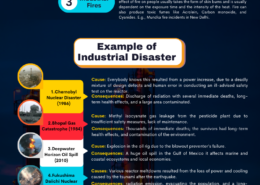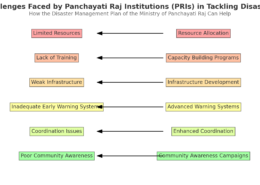Talk about how disaster management plans in India need to take traditional knowledge and indigenous traditions into account.
Model Answer Introduction A tsunami is a catastrophic oceanic event, primarily caused by submarine earthquakes, volcanic eruptions, or landslides. On December 26, 2004, an undersea megathrust earthquake off the west coast of northern Sumatra triggered one of the deadliest natural disasters in historRead more
Model Answer
Introduction
A tsunami is a catastrophic oceanic event, primarily caused by submarine earthquakes, volcanic eruptions, or landslides. On December 26, 2004, an undersea megathrust earthquake off the west coast of northern Sumatra triggered one of the deadliest natural disasters in history, severely impacting 14 countries, including India. This tragedy highlighted the urgent need for a robust disaster preparedness strategy, as outlined by the National Disaster Management Authority (NDMA) in 2010.
Factors Responsible for Tsunami Occurrence
A. Submarine Earthquakes
The 2004 tsunami was primarily triggered by a powerful undersea earthquake at the boundary of the Indian and Burmese tectonic plates, registering a magnitude of 9.1.
B. Water Displacement
The vertical movement of the earthquake displaced vast amounts of water, generating waves that traveled across the Indian Ocean at high speeds, affecting coastal areas far from the epicenter.
Effects on Life and Economy
A. Human Impact
The tsunami resulted in the loss of over 230,000 lives globally, with India’s coastal regions, particularly Tamil Nadu and the Andaman and Nicobar Islands, suffering devastating casualties.
B. Infrastructure Damage
Critical infrastructure, including the Indira Gandhi Hospital in the Andaman and Nicobar Islands, sustained significant damage, impairing healthcare services in affected areas.
C. Socio-Economic Disruption
The fishing industry in regions like Nagapattinam faced severe losses, negatively impacting livelihoods and leading to widespread economic hardship.
NDMA Guidelines for Preparedness
A. Early Warning System
The Indian Tsunami Early Warning System (ITEWS) was established at the Indian National Centre for Ocean Information Services (INCOIS) to enable faster tsunami assessments and alerts.
B. Structural Mitigation Measures
Coastal structures in tsunami-prone areas, such as Kerala, have been upgraded to better withstand tsunami impacts.
C. Non-Structural Measures
Community-based disaster management programs in states like Odisha have effectively reduced risks and enhanced local resilience.
D. Capacity Building
Training for National Disaster Response Force (NDRF) personnel, healthcare professionals, and local communities has been prioritized to improve response efforts.
E. Awareness Generation
Public awareness campaigns in coastal regions aim to educate residents about tsunami risks and safety measures.
Conclusion
The 2004 tsunami underscored the destructive potential of natural disasters and the importance of preparedness. Following NDMA guidelines, India has made significant improvements in disaster risk reduction, yet further efforts are essential, particularly at the community level, to foster resilience against future catastrophes. Enhancing our ability to respond to natural disasters remains a critical challenge, especially in the context of climate change.
See less


Discussing the Necessity of Incorporating Traditional Knowledge and Indigenous Practices into Disaster Management Strategies in India 1. Introduction Incorporating traditional knowledge and indigenous practices into disaster management strategies is essential for creating comprehensive and culturallRead more
Discussing the Necessity of Incorporating Traditional Knowledge and Indigenous Practices into Disaster Management Strategies in India
1. Introduction
Incorporating traditional knowledge and indigenous practices into disaster management strategies is essential for creating comprehensive and culturally sensitive approaches. In India, which is diverse in terms of geography and cultures, traditional knowledge offers valuable insights into managing disasters effectively. This discussion explores the necessity of integrating these practices into modern disaster management strategies, highlighting recent examples to illustrate their relevance.
2. Importance of Traditional Knowledge and Indigenous Practices
A. Enhancing Local Relevance and Effectiveness
1. Context-Specific Insights: Traditional knowledge often provides context-specific insights that can enhance disaster management strategies. Indigenous practices, developed over generations, are tailored to local environmental conditions and risks. For example, the use of bamboo construction techniques in flood-prone areas of Assam demonstrates how traditional practices are adapted to mitigate flood impacts.
2. Community Resilience: Indigenous practices promote community resilience by fostering a sense of ownership and collective responsibility. In the Madhya Pradesh region, the Gond and Baiga tribes have traditional systems for managing water resources and coping with droughts, which are integral to local resilience and sustainability.
B. Preserving Cultural Heritage and Practices
1. Cultural Sensitivity: Incorporating traditional knowledge into disaster management respects and preserves cultural heritage. It ensures that disaster management strategies are culturally sensitive and acceptable to local communities. For example, the tribal knowledge of the Naga people in Nagaland includes traditional forecasting methods and community-based responses to natural hazards, which are respected and integrated into modern disaster planning.
2. Holistic Approaches: Traditional practices often involve a holistic approach to disaster management that integrates environmental, social, and spiritual aspects. The Rural Development Foundation’s initiatives in Tamil Nadu incorporate local rituals and practices into disaster preparedness programs, recognizing their role in community cohesion and resilience.
3. Recent Examples of Integrating Traditional Knowledge
A. The 2004 Tsunami Response in Tamil Nadu
1. Context and Response: Following the 2004 Indian Ocean tsunami, there was a notable use of traditional knowledge in the response and recovery phases. Coastal communities in Tamil Nadu, who had historical knowledge of tsunamis and sea-level changes, utilized traditional warning signs and evacuation routes to enhance their response.
2. Integration into Modern Strategies: Efforts were made to integrate this traditional knowledge with modern scientific approaches. For example, the Indian National Centre for Ocean Information Services (INCOIS) has since worked on combining traditional practices with advanced forecasting models to improve community-based tsunami warning systems.
B. The Flood Management Practices in Assam
1. Context and Practices: In Assam, traditional flood management practices, such as the construction of bamboo stilts for houses and the creation of flood-resistant agricultural techniques, have been used for centuries. These practices are based on indigenous knowledge of local flood patterns and river behavior.
2. Modern Integration: Recent disaster management strategies in Assam have incorporated these traditional practices alongside modern techniques. The Assam State Disaster Management Authority (ASDMA) collaborates with local communities to integrate traditional flood management methods into broader flood risk reduction strategies.
C. The Role of Indigenous Knowledge in Drought Management in Rajasthan
1. Context and Practices: In Rajasthan, indigenous practices such as rainwater harvesting techniques (e.g., Johads) and the use of traditional water storage systems have been crucial in managing droughts. These practices reflect deep knowledge of local water scarcity and soil conditions.
2. Policy Integration: The Rajasthan Government has recognized these practices and incorporated them into its drought management policies. The Integrated Watershed Management Programme (IWMP) includes traditional water conservation practices as part of its approach to managing water resources in arid regions.
4. Recommendations for Incorporating Traditional Knowledge
A. Documenting and Validating Traditional Knowledge
1. Systematic Documentation: Efforts should be made to systematically document traditional knowledge related to disaster management. This can involve collaborating with local communities and experts to compile and validate traditional practices.
2. Research and Validation: Research should be conducted to validate the efficacy of traditional practices and integrate them into scientific disaster management frameworks. This can include field studies and pilot projects to test traditional practices in modern contexts.
B. Strengthening Community Participation and Partnerships
1. Inclusive Planning: Disaster management planning should include active participation from indigenous communities. Engaging local knowledge holders in planning processes ensures that strategies are relevant and acceptable to those most affected.
2. Building Partnerships: Strengthening partnerships between government agencies, NGOs, and local communities can facilitate the integration of traditional knowledge into disaster management strategies. Collaborative efforts can enhance the effectiveness of disaster response and recovery.
C. Education and Training
1. Training Programs: Developing training programs that educate disaster management professionals about traditional knowledge and practices can enhance their understanding and integration into strategies.
2. Awareness Campaigns: Conducting awareness campaigns to inform communities about the value of traditional knowledge and its role in modern disaster management can foster acceptance and support.
5. Conclusion
Incorporating traditional knowledge and indigenous practices into disaster management strategies in India is essential for creating effective, culturally sensitive, and locally relevant approaches. Traditional practices provide valuable insights into local risks and resilience mechanisms, enhancing the overall effectiveness of disaster management. Recent examples such as the use of traditional practices in Assam and Rajasthan illustrate the benefits of integrating these approaches. By documenting, validating, and incorporating traditional knowledge, and fostering community participation, India can enhance its disaster management strategies and build more resilient communities.
See less